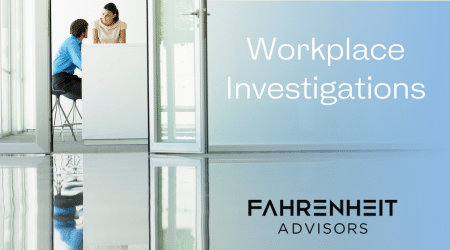Is Your Organization Prepared to React to a Workplace Misconduct Accusation?

Imagine an employee in your organization is accused of workplace misconduct. What do you do?
From fraud and bribery, to bullying and harassment, to substance use and other policy violations, workplace misconduct comes in many forms and is, unfortunately, not an uncommon issue. A recent survey revealed almost half of office workers experience workplace misconduct as often as at least once a month, and 75 percent of U.S. office workers have witnessed some form of office misconduct in their career.
As a leader, as a manager, and as an organization, are you prepared to react to a workplace misconduct accusation? If your answer is not a definitive “yes,” read on. In this blog we’ll walk through why using an external expert for workplace misconduct investigations is imperative, we’ll review a specific accusation scenario and point out the differences between an internal and external investigator, and we’ll share what we do here at Fahrenheit so you know better what to expect during a workplace misconduct investigation.
Using an external investigator proteCts your organization
When faced with allegations of employee misconduct, many organizations aren’t sure where to turn. The stakes are high. There are a whole host of potential legal and financial impacts to consider. Workplace misconduct and how it is handled can also negatively affect culture, loyalty, and trust — all of which have repercussions for retention. In fact, employees who experience or witness misconduct and harassment leave their jobs at higher rates. And we’ve all seen national headlines about organizations that have reportedly mishandled misconduct allegations, which leads to serious reputational consequences as well.

Such situations demand a thorough, professional, unbiased investigation that most organizations aren’t prepared to manage or aren’t capable of effectively delivering. Seeking external investigation experts, like Fahrenheit’s Investigations Team and HR Compliance advisors, will ensure your organization is protected during a workplace misconduct investigation.
Why isn’t it a good idea to use internal resources for a workplace misconduct investigation? First, in-house investigators or legal counsel have a stake in the outcome, which increases the chance of bias allegations, communication breakdowns, and broken confidentiality. Second, most companies don’t have dedicated resources for conducting investigations, which means the process may not get the attention or professionalism it requires. And, finally, assigning the responsibility of an investigation to someone without the requisite knowledge of employment law could cause costly missteps.
Exploring an accusation scenario
Let’s use an accusation scenario to illustrate the differences between using internal and external resources to conduct a workplace misconduct investigation.
The situation
Kevin is the HR Director for large accounting firm. He recently received an anonymous phone call from a woman who told him: “Your employee Brian is an alcoholic, and he is drunk at work all the time. I should know because I’m his ex-girlfriend.”
The reaction
Kevin is inclined to ignore the complaint, because he thinks the caller is probably just being vindictive, and because Brian is a talented accountant with excellent reviews. But he also recognizes the stakes are high. So Kevin asks one of the HR managers, Tanya, if she’s heard anything about Brian being drunk at work. Tanya confirms to Kevin: “Yes, I heard something about that from his team’s administrative assistant — she has all the good gossip!” Kevin is upset that his manager Tanya never escalated the concern to him, and he intends to address that with her later. But first he knows he needs to investigate the accusation. Kevin approaches the team lead, Lila, who is a CPA. Lila says: “I’ve handled workplace investigations before, I’ve got this.”
The question
What should Kevin do?
Scenario A: Kevin asks Lila to handle the investigation internally
Lila begins by interviewing every employee on the team. Her first question to everyone is: “We think Brian has a drinking problem, what do you know?” Through the questioning, she learns Brian has been observed passed out in the bathroom, sleeping at his desk, and drinking at the nearby pub over lunch. During the interviews, she also asks everyone: “Why didn’t you tell me about this before?” This question makes the employees worry they might be in trouble, and they question how much more they should share with Lila.
A few employees reluctantly agree that they think Brian has a drinking problem. Others tell Lila that they don’t know whether he’s drinking at work or whether he might have a medical condition, but either way, they have observed him asleep and feel like it’s none of their business. Lila concludes that she has enough information to terminate Brian, based on the few witnesses who agreed with her conclusion about his abuse of alcohol. Kevin, on the other hand, is not comfortable that the witness statements draw any obvious conclusion about use of alcohol at work. First, many of the comments are not necessarily based on Brian’s observable conduct, rather, they are simply supporting the comment that Lila made at the outset of her questioning, that “we think Brian has a drinking problem.” Second, because witnesses reported feeling intimidated by Lila’s agitation, he is somewhat concerned that they only agreed with her to appease her. Adding to his concern about the witness intimidation is that Lila failed to start her interviews with an anti-retaliation statement, make efforts to put witnesses at ease, and ask open-ended, fact-finding questions. Finally, the witnesses who were reluctant to draw any conclusions about Brian’s conduct opened the door to other possible reasons for his behavior at work; specifically, that medical conditions might be the cause of his concerning workplace behaviors. As a result, he does not agree that there is an obvious violation of the company’s Drug and Alcohol Policy and believes the investigation is flawed.
Scenario B: kevin hires an external investigator
The investigator begins by learning about the company and the allegation, and sets up meetings with key employee witnesses. Prior to each meeting, the investigator makes each employee witness comfortable and reassures them they are protected against retaliation for their participation. The investigator asks a series of open-ended questions and listens while each employee witness provides observations and information about what they know. During the conversation, the investigator learns about Brian’s observed behavior and the names of other possible employee witnesses. Some employee witnesses remember behaviors that didn’t seem concerning at the time, but share them with the investigator in case it’s relevant now. When the meeting is over, all employees agree to get in touch with the investigator if they think of anything else. After meeting with a number of employee witnesses, the investigator is able to draw some factual conclusions and make thoughtful recommendations to Kevin that consider the organization’s policies as well as all applicable state and federal laws.
Kevin and Lila review the investigator’s findings and recommendations and it appears that there is sufficient evidence for them to draw the conclusion that Brian has been drinking alcohol during his lunch breaks to the point of feeling ill or otherwise incapacitated during the workday. These actions clearly violate their company’s Drug and Alcohol Policy and they determine that he should be subject to corrective action.
the review: what went wrong with lila’s internal investigation?
1.) Lila started each meeting with a bias about the outcome of the investigation. She did not ask open-ended questions, rather she asked leading questions that assumed the conclusion. Lila is not an HR professional, and she is not up to date on employment laws nor is she skilled in the nuanced communication style necessary for a workplace investigation.
The external expert understands the complexities of employment law and was guided by this knowledge throughout the interview process, including what questions were asked and how so as not to assume outcomes or introduce bias.
2.) Lila did not open the meeting with a statement about retaliation concerns or set the tone for a comfortable meeting environment. Most witnesses in workplace investigations have never participated in a conversation like this, and they can be nervous about being called into a meeting.
The external expert made sure employee witnesses were comfortable during the investigation conversations, and reassured them from the outset they would be protected from retaliation for their participation.
3.) Because Lila is the employees’ manager, they are likely to be intimidated by her and less likely to be forthcoming with information. They may also fear retaliation, which wasn’t helped when Lila chastised them for not coming forward sooner.
The external expert is an impartial third party, giving employee witnesses the confidence to freely share information and observations. The external expert also did not question why employee witnesses did not come forward sooner.
The takeaway
Employee witnesses who are nervous, fear retaliation, or are asked leading questions will immediately shut down and not provide sufficient information to help the investigation draw reasonable conclusions or provide solutions that help your organization. Employees don’t report misconduct because of reasons like not feeling comfortable, not trusting it will be handled appropriately, or being afraid of consequences. Many of these same fears also apply in an investigation scenario. An experienced external investigations expert is the answer for a better process — as well as a better outcome.
In part 2 of this article, we will cover what to expect during a workplace investigation.
Fahrenheit’s workplace investigators are highly skilled to help you conduct a thorough, fair, and compliant investigation, with as little disruption to your workplace as possible. Our goal is to gather as much information as possible to help you make the best possible decision for your organization. We’ll recommend any interventions that we think will move your company forward in a positive and healthy way and ensure that your decisions are aligned with state and federal laws, your internal policies, and your cultural and strategic goals.
VIEW FAHRENHEIT ADVISORS WORKPLACE INVESTIGATION CAPABILITIES
Read part 2 of this series
About the author
 Leigh Archer is a strategic human resource professional focused on connecting culture and employee engagement with practical policies and procedures. Connect with Leigh on Linkedin.
Leigh Archer is a strategic human resource professional focused on connecting culture and employee engagement with practical policies and procedures. Connect with Leigh on Linkedin.

